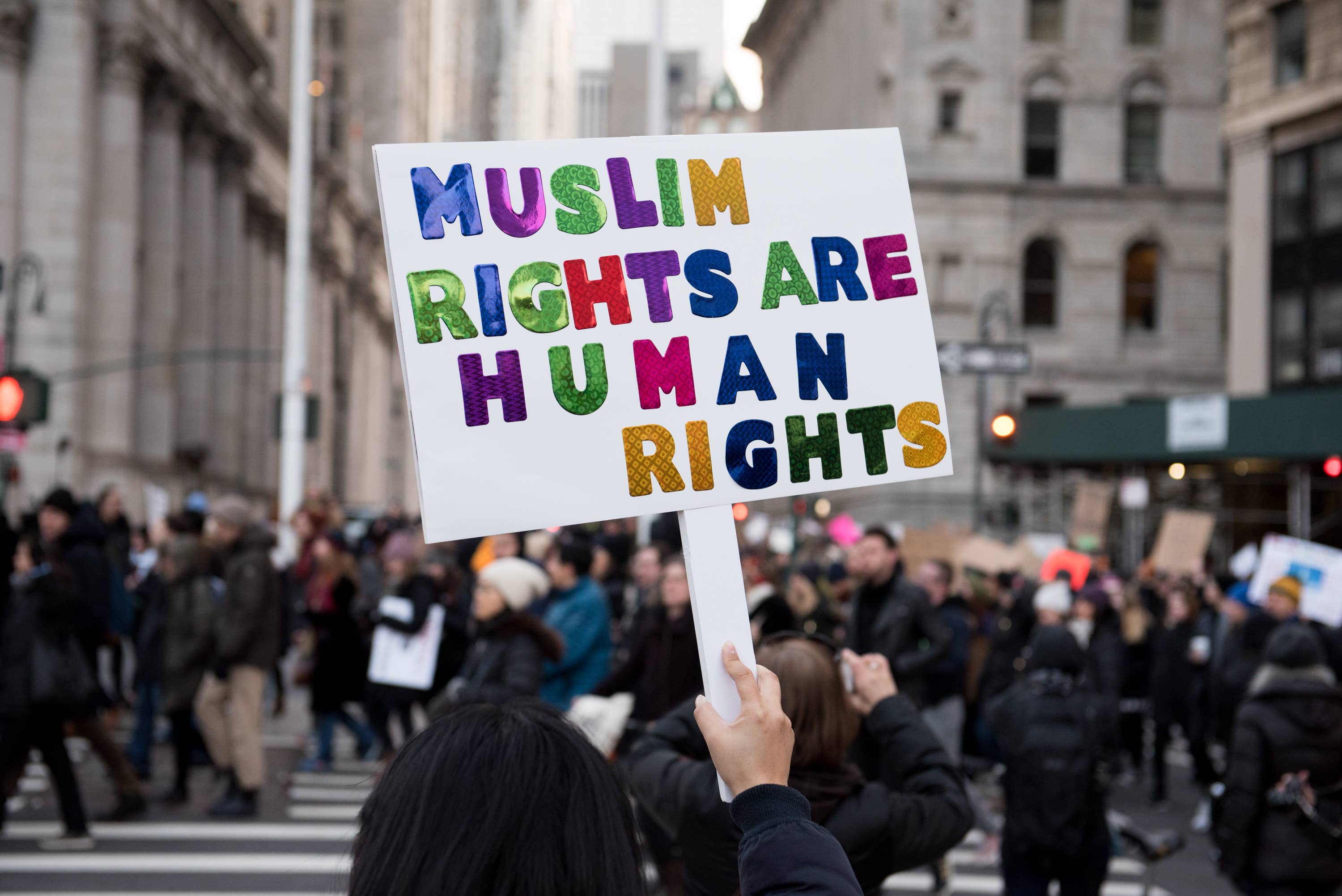
Sometimes, a promise is a promise. On Friday, Donald Trump signed an Executive Order titled “Protecting the nation from foreign terrorist entry into the United States,” or in other words, an initial rollout of his Muslim ban. With a simple stroke of a pen, President Trump created chaos, confusion, and effectively temporarily barred millions of people from entering the United States. While Trump is currently one of the loudest voices of Islamophobia, he's just one part of a bigger culture of dehumanizing Muslims.
The Executive Order bans citizens of seven Muslim-majority countries—Iraq, Libya, Sudan, Iran, Syria, Somalia and Yemen—from entering the U.S. for at least 90 days. It also suspends the U.S. refugee program for four months and bans Syrian refugees indefinitely. The EO calls for new immigration screening procedures and also places a cap at 50,000 for refugees allowed entry in 2017 (less than half of the 110,000 limit set by Obama). The order also prioritizes refugees that claim religious-based persecution—but only if their religion is a minority in their country, such as Christians in Muslim countries (a move criticized by Christian leaders). Another troubling aspect of this legislation is that it leaves the door open for other countries to be added down the line, which Trump’s aides are already publicly discussing.
WATCH: ACLU Executive Director Anthony D. Romero coming out of the court where the ACLU just argued and won block of Trump's Muslim ban. pic.twitter.com/kvWDgWiUIn
As residents from the list of "banned countries" were detained at airports throughout the U.S., spontaneous demonstrations erupted across the nation. Chanting things like “let them in” and “no ban, no wall.” protesters from diverse backgrounds gathered at dozens of airports, marched in front of the White House, and in cities from coast-to-coast. Immigration attorneys volunteered their time—even sitting on airport floors with their laptops—working diligently to fight back against this EO and free detainees. On Saturday evening, their efforts paid off. A federal judge in Brooklyn granted a temporary stay order, blocking the deportation of those who arrived with a valid visa and those with approved refugee applications.
The longer fight however, is far from over; this is likely just the beginning of the Trump Administration's plan. They’re testing the waters, but the question remains: How did we get to this point?
In December of 2015, Trump made international headlines while on the campaign trail when he called for a “complete and total shutdown” of Muslims entering the United States. He later attempted to backpedal by explaining that it would be a ban from areas with a history of terrorism, and then altered his statement again by claiming that this was going to be “extreme vetting.”
But no matter Trump's spin, the damage was done. Muslims—who have been othered for decades—were openly demonized on the national stage by a Presidential candidate. Unfortunately, it worked. Not only did Trump get away with his outrageously offensive and vile statements (which he's now following through), but his message resonated with many of his supporters.
Trump may be the face of his latest measure to dehumanize Muslims, but he's part of a larger concerted societal effort.
Trump may be the face of his latest measure to dehumanize Muslims, but he's part of a larger concerted societal effort. Whether it's in media, pop culture, or the words of elected officials, Muslims have been stereotyped, castigated, and vilified for years. They're often depicted as perpetrators of violence, even though Muslims are actually the ones who suffer the greatest from acts of terrorism. Their voices are rarely brought into national conversations to the point where cable news networks can have entire segments about Muslims without ever inviting one to the table. When most Americans don’t know a Muslim personally (or don’t realize that they know one), it’s not surprising that many believe the false narratives that have been shaped about us and without us. This ignorance is what Trump seized upon.
Hours after Trump signed this EO, a mosque in Texas was set on fire, and earlier in the week, a man was charged with hate crimes after reportedly threatening and assaulting a Muslim airline employee who was wearing a headscarf. He allegedly said "Trump is here now. He will get rid of all of you," during the attack. These are just the latest in a slew of attacks against Muslims (and those perceived to be Muslim) and their houses of worship. In November, the FBI released a report indicating that hate crimes against Muslims shot up 67 percent in 2015—the highest levels since September 11th. There have also been several studies highlighting the correlation between the Presidential campaign cycle and the rise of Islamophobia and hate crimes.
These drastic measures and ill-conceived actions can be rooted in fear of the unknown. Is terrorism a real problem? Absolutely. But it’s important to remember that Americans are seven times more likely to be killed by a right-wing extremist than by an extremist who claims to be Muslim.
Today, at Detroit Metro Airport, protesters made room for Muslims to pray.
They used protest signs as prayer mats.#nomuslimban pic.twitter.com/8SW8Pphhbo
Capitalizing on people’s fears (based on misinformed stereotypes), Trump promised a false sense of security both during his campaign and now with this Muslim ban. Thankfully, many—even some who voted for Trump—are seeing through this façade. That’s why tens of thousands of Americans from all stripes rallied to the side of refugees, immigrants, and Muslims this weekend. Whether they were Christian, Jewish, Hindu, or atheist, the people marched and aligned themselves with some of the world's most vulnerable populations, who arrived at America's doorstop seeking refuge.
The Muslim community in the U.S. and throughout much of Europe is on edge; hate crimes are on the rise and the climate is tense, but there is also tremendous hope in the sheer number of people who mobilized almost instantaneously to fight against this Muslim ban. As Trump and his team continue to test how many dangerous policies they can implement, it is up to us—the American people—to stand on the right side of history. If this weekend’s protests were any indication, Trump’s Muslim ban promise could well be turned into delusions of grandeur.

